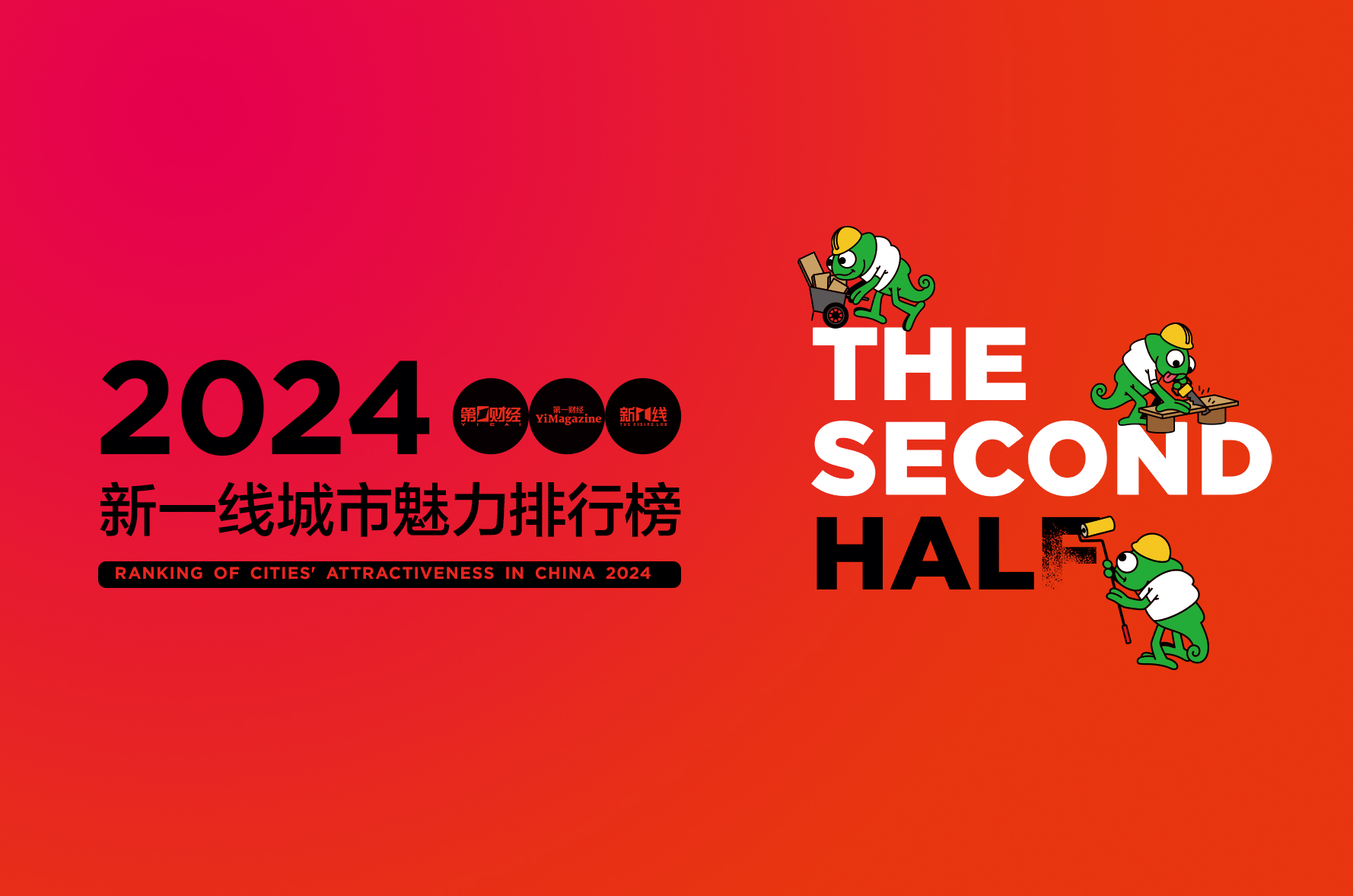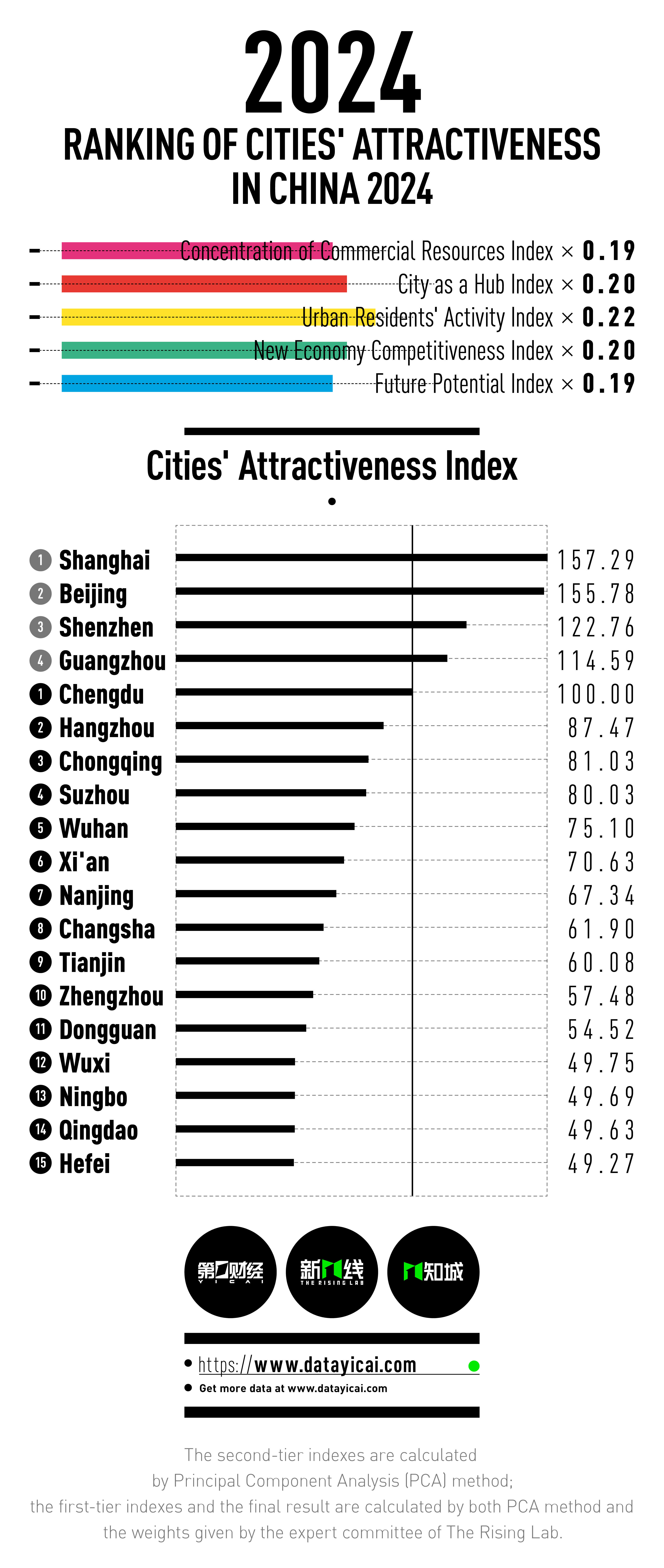 Yicai's Rising Lab Adopts New System to Evaluate Chinese Cities' Attractiveness
Yicai's Rising Lab Adopts New System to Evaluate Chinese Cities' Attractiveness(Yicai) May 30 -- The Rising Lab, the city-oriented big data platform of Yicai Media Group, has released the Ranking of Cities' Attractiveness in China 2024, which was compiled using a revised evaluation system that is more aligned with the new development stages of Chinese cities.
China's urbanization process is entering a new stage where growth will no longer be inevitable. Over the past 30 years, the economic data for Chinese cities have steadily risen, people have continuously migrated into urban areas, and large cities have enjoyed long-term prosperity. But the speed and pace of the golden development period for the cities may not be as easy to replicate.
The ranking makes use of data from mainstream consumer brands, user behavior data from leading internet firms, and big data from institutional providers to assess the development of Chinese cities based on five indexes. The New Economy Competitiveness Index was added to the existing indexes Concentration of Commercial Resources, City as a Hub, Urban Residents’ Activity, and Future Potential. The Lifestyle Diversity Index was removed.

Shanghai tops the list of China's first-tier cities in the 2024 rankings, followed by Beijing, Shenzhen, and Guangzhou.
Chengdu ranked first among new first-tier cities, followed by Hangzhou, Chongqing, Suzhou, Wuhan, Xi'an, Nanjing, Changsha, Tianjin, Zhengzhou, Dongguan, Wuxi, Ningbo, Qingdao, and Hefei.
Wuxi in China's eastern Jiangsu province made the new first-tier cities list this year after five years. It passed Ningbo, Qingdao, and Hefei to rank 12th. Meanwhile, Kunming, the capital city of China's southern Yunnan province, moved down the rankings to become a second-tier city.
Yicai published the rankings for the first time in 2016, but had coined the term 'new first-tier city' three years before.
“In the next few years, many indicators of multiple second-tier cities in China will reach the same level as what first-tier cities have now,” Yicai wrote on the cover of the edition of China Business News Weekly published on Aug. 5, 2013. “Large companies are looking for these cities and trying to contribute to their upgrading. We name them new first-tier cities.”
The findings below are based on this year’s rankings:
> China's commercial landscape is stabilizing, and the progress of commercial civilization has not stalled. The commercial sectors in almost all cities are saturated, and the market has entered a period of calm. Commercial operators are pondering how to revitalize limited inventory space and resources to best adapt to the lifestyle interests of contemporary urban residents.
> Urban networks are becoming entrenched, and the opportunity period for new first-tier cities is being extended. The urban network system and hierarchical structure are basically fixed. Small and medium-sized cities need smarter strategies and also a bit of luck to break through the current urban landscape.
> Young people's city choices no longer follow a mainstream pattern. The appeal of cities to young people has changed. Generation Z members hope to establish a ‘like-minded’ relationship with a city rather than a simple bond based on interests.
> There is a rotation in the new economy sectors, but new narratives are far from enough. In recent years, cities across China have been attempting to stimulate the new economy’s growth, but industrial development does not yield results as quickly as urban construction, as it requires a foundation in scientific research, a talent structure, strong supply chains, and a supportive business environment.
The following is a guide to the five indexes used in compiling the Ranking of Cities' Attractiveness in China 2024.
The Ranking of Cities' Attractiveness in China 2024 was put together based on five major indexes, also called dimensions: Concentration of Commercial Resources, City as a Hub, Urban Residents' Activity, New Economy Competitiveness, and Future Potential.
Under this year’s revised evaluation system, the Lifestyle Diversity Index, which focused on younger people’s consumption and cultural leisure activities, was removed as a standalone dimension and subsumed into those for Concentration of Commercial Resources and Urban Residents' Activity. The New Economy Competitiveness Index was added.

> Concentration of Commercial Resources Index: this measures the degree to which a city is favored by mainstream consumer brands, the strength of a city's business clusters, and the maturity of its basic businesses. It is composed of three sub-indexes: the Big Brands' Attraction Index, Commercial Core Index, and Basic Commerce Index.
Some 264 Chinese cities reported an increase in the scale of their leisure and commercial entertainment amenities last year, while only 91 saw a growth in the scale of their commercial convenience amenities.
> City as a Hub Index: this measures the connectivity of transport and logistics and the reach of urban commercial resources. It consists of four sub-indexes: the Traffic Connectivity Index, Intercity Flow Index, Industry Collaboration Index, and Business Resource Regional Primacy Index.
Last year, China’s civil aviation sector was still recovering from the effects of the Covid-19 pandemic. Passenger throughput in most cities and airports has not yet returned to the same levels as in 2019, but popular routes have already seen a swing back to positive growth.
> Urban Residents' Activity Index: this mainly measures the degree of vibrancy among urban residents by consumption, leisure, and night-time activities. It comprises three sub-indexes: the Consumption Activity Index, Social Networking Activity Index, and Night Life Index.
The tourism and live-performance sectors are fully recovering, with tourism consumption in popular destinations, such as Zibo, Yanbian, Luoyang, and Harbin, surging more than four times from the year before.
> New Economy Competitiveness Index: this focuses on the impact of high-quality enterprises on the urban economy, the online and offline vitality of new consumption patterns, and the structural advantages and sustainable development trends of supply chains. It includes three sub-indexes: the Leading Company Index, New Consumption Index, and Industrial Chain Ecology Index.
Chinese cities such as Changsha, Hangzhou, and Chengdu have seen a number of new consumer brands emerge.
For cities like Changsha, Shenyang, Xiamen, and Harbin, their rankings in the Xiaohongshu Index are higher than their overall rankings. The Xiaohongshu Index evaluates the vibrancy of a city’s consumption based on the posting activity on Chinese lifestyle and e-commerce platform Xiaohongshu, also known as Little Red Book.
In emerging industries, such as integrated circuits, artificial intelligence, biomedicine, new energy, and high-end equipment, cities like Suzhou, Nanjing, Xi'an, and Hefei have all made significant achievements in their respective areas of expertise.
> Future Potential Index: this focuses on the resilience of cities amid changing conditions in their environment while maintaining sound development. It has three sub-indexes: the Innovation Index, Talent Attractiveness Index, and Urban Scale Index.
Corporate innovation activity is at its highest in the cities of Shenzhen, Beijing, and Ningbo. Last year, Jinan and Ningbo ranked among the top 10 nationwide in terms of primary market funding growth.
Medical resosurce service capacity and digital governance capability are newly added tertiary dimensions this time, used to measure the attractiveness of a city's public service capacity to talented individuals when choosing a city.
Editor: Futura Costaglione